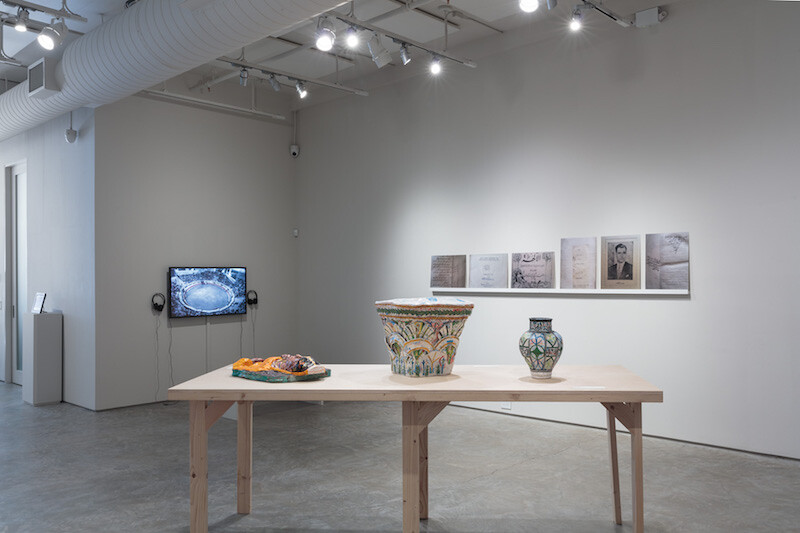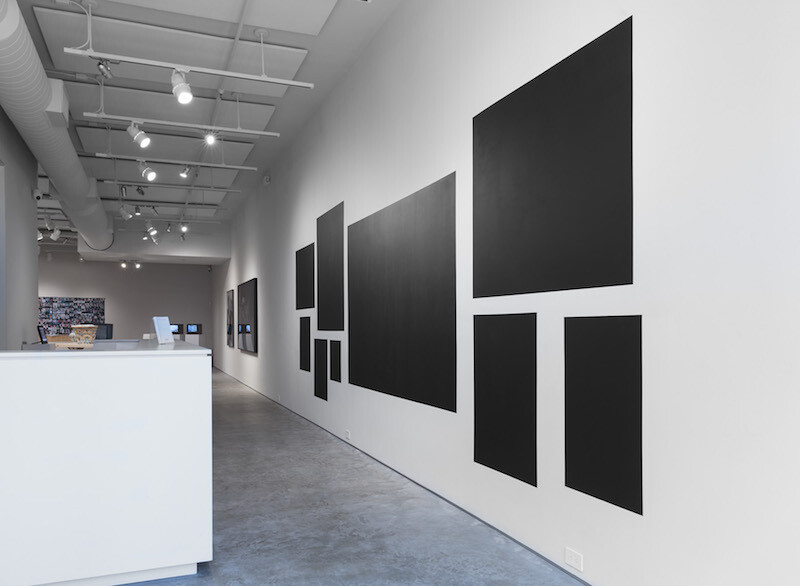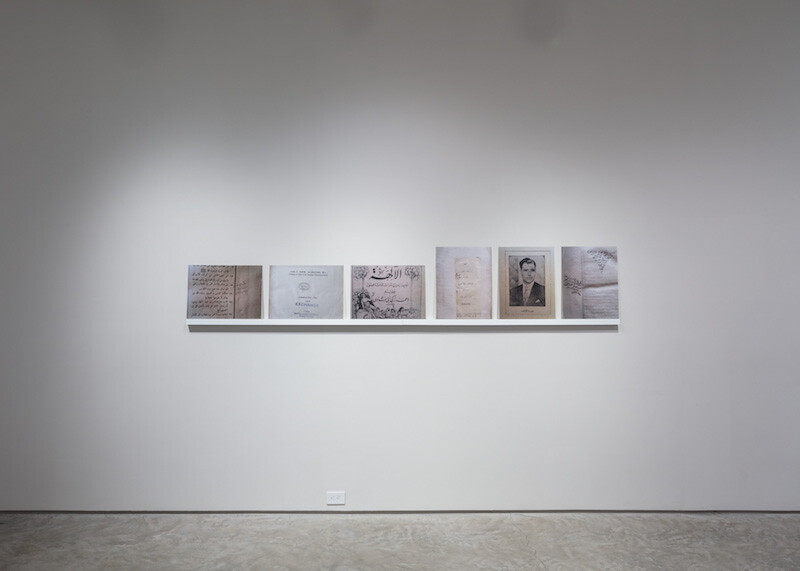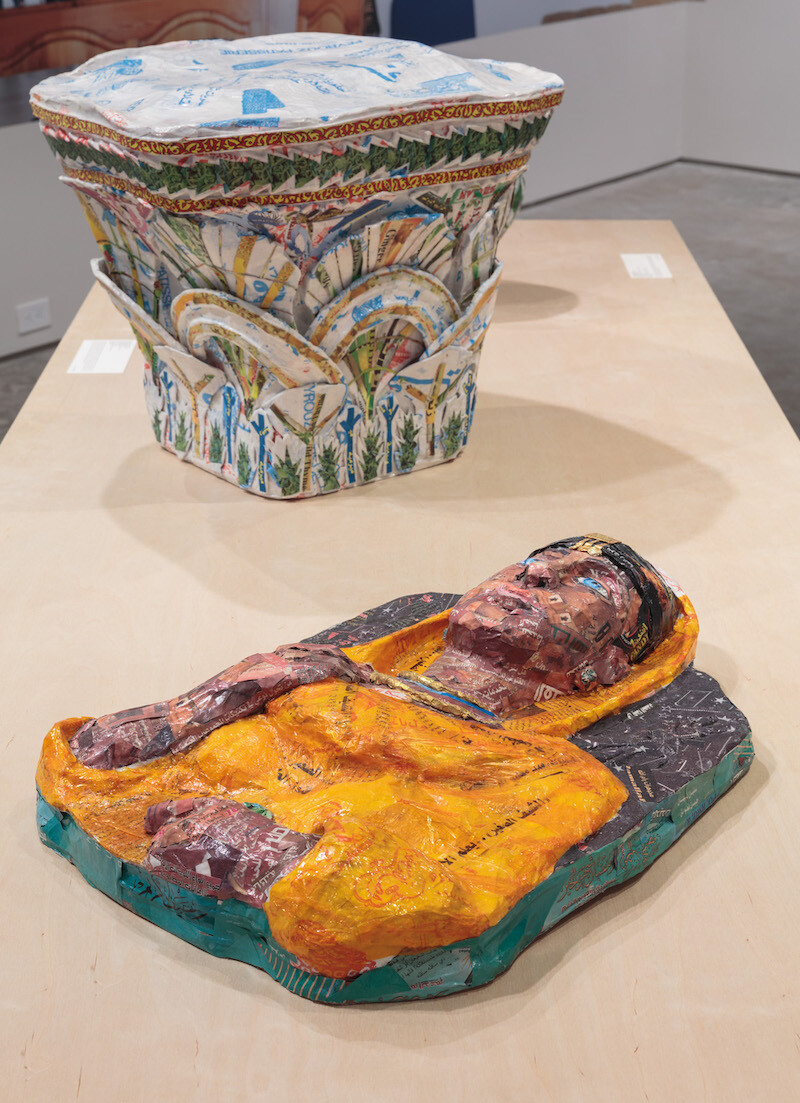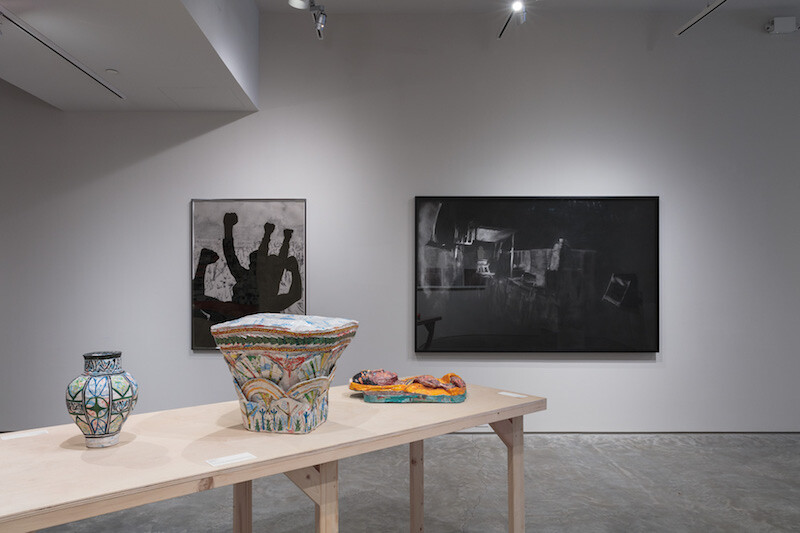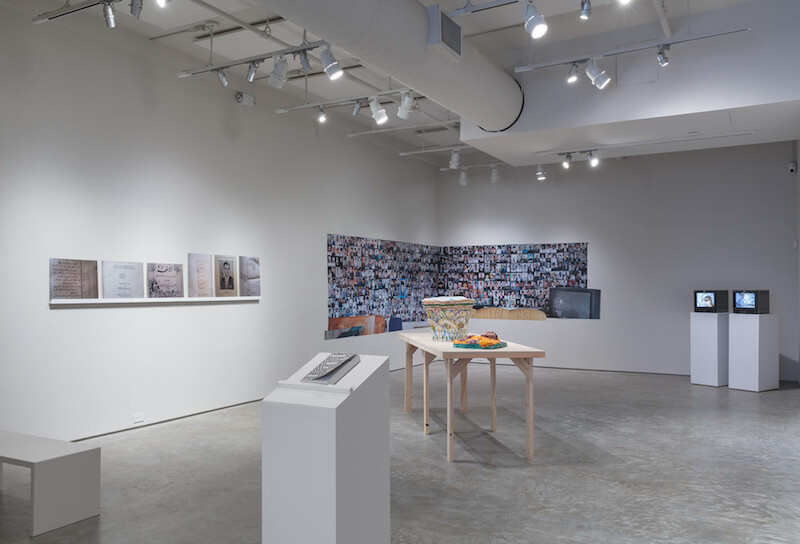In his press release for “A Void,” a group exhibition at 601Artspace, curator and artist Paul Ramírez Jonas provides an epigraphic clue to the relationship he sees between various forms of displacement that result in a void: “When books burn, people burn.” The phrase, according to the press release, is a quote by Iraqi-American artist Michael Rakowitz, one of eight artists in the show.1.] Their works render the violent displacement and death of people: Palestinians, Syrians, African Americans, Bosnian Muslims, Colombians, French Jews during the Holocaust, and female victims of domestic abuse in Ecuador.
The exhibition is bifurcated: on the largest wall of the narrow gallery, Ramírez Jonas has painted eight large black rectangles, which are meant to represent the absence of eight Western European paintings destroyed over the course of World War II by both sides and, thus, to illustrate his curatorial intervention. Past these voids and into the gallery, eight artworks are installed simply but effectively. A new work by Aida Šehović, Family Album (ŠTO TE NEMA): Wall 6 and 7 (2018), covers the gallery’s back corner with a one-to-one scale photographic reproduction of two walls in the Women of Srebrenica Association office, a nonprofit dedicated to identifying the victims of the Srebrenica massacre in Bosnia in 1995. The majority of the photo-mural is devoted to rows upon orderly rows of 4 x 6 photo snapshots of missing men that line the office, each a reminder of absence and collectively a testament to the scale of the genocide.
Six photographs from Emily Jacir’s “Untitled (fragment from ex libris)” (2010–12) are printed from cell phone photos the artist took of books held by at the National Library of Israel. The books she documents were designated as abandoned property and are part of a collection of nearly 30,000 volumes which once stood on the shelves in Palestinian homes and were seized by Israeli authorities in 1948. Jacir’s camera closes in on handwritten marginalia in order to try and focus the viewer’s attention not only on the books as objects displaced from their proper socio-linguistic histories, but also as objects that once belonged to individuals rather than to an ethnic identity writ large and in the abstract.
Šehović and Jacir’s works force the viewer to oscillate between an encounter with the individual victim and an understanding of the broader structural forces that made entire ethnic groups vulnerable to genocide and mass displacement. Theirs, and the work of the other six artists Ramírez Jonas has gathered, show an extraordinary subtlety in their apprehension of the objects that stand in for the absence of people, their bodies, and their potential histories. At the heart of Ramírez Jonas’s proposal, however, is the juxtaposition of the disappearance of people with that of eight paintings—signified by the black voids that greet the viewer upon entry. With this comparative gesture, Ramírez Jonas hopes to provide insight into the way artwork can continue to affect discourse in its absence. “(I)t is not just about the void left by death and destruction,” Ramírez Jonas writes in his press release. The exhibition “asks how the loss that results from a massacre, mass murder, genocide, ethnic cleansing, or pogrom transcends each personal injury and becomes an injury to all?”
Yet the pairing “A Void” makes between Van Gogh’s Painter on the Road to Tarascon (1888), destroyed by Allied bombing in 1945, and the 1995 genocide of over 8,000 Bosnians to which Aida Šehović’s work responds, is an awkward curatorial gesture. People are not really comparable to objects, and neither is their loss. The genocide of Bosnian Muslims in the Balkans was not authorized by the same discourse as the atomic bombing of Japan in 1945. Racism and sexism are evolving practices of power, like viruses that adapt to the changing conditions of appearance.
The artworks Ramírez Jonas has curated into “A Void” resist his universalizing premise by systematically implicating the audience in the void being represented. One example is Michael Rakowitz’s “May the Obdurate Foe Not Be In Good Health” (2016), a series of sculptural reproductions of artifacts destroyed or looted during the Syrian Civil War. He does so by reconstructing the fragments of ancient Middle Eastern civilizations out of commercial food packaging imported to the US from Syria. The implication is that the people to whom these ancient objects once belonged are not simply absent from their original context, but have been displaced to the US where they can buy syrup from back home for as long as the conditions of production are still stable enough to export it out of Syria.
As admirable as the attempt to draw a broad comparison across a wide range of socio-political contexts is, it also collapses some important differences, such as that between victim and perpetrator. For example: Shaun Leonardo’s gorgeous, large-scale charcoal drawing, Stephon Clark (2018) is almost abstract in its representation of the backyard of the home in Sacramento where Stephon Clark, the unarmed father of two, was shot to death by two police officers, each of whom fired ten times in the space of six seconds. Leonardo’s drawing is rendered from the perspective of the one of the officers’ body cams, thus putting the viewer in the position of an officer who has become a vector for lethal structural racism. To emphasize this point, Leonardo has placed a small fragment of reflective material onto the glass used to frame the drawing, like a shard of dark mirror. The drawing is made with reference to a single still of the body cam’s footage, and the mirrored shard is cut to the shape of Clark’s body in that still. Viewers can see themselves clearly in the void created by this mirrored fragment against the drawing’s otherwise ambiguous, dissociative charcoal ground.
Ramírez Jonas’s is an understandable call for universal solidarity, but I strongly question whether everyone feels loss in the face of the overwhelming numbers of young black and brown women and men incarcerated or murdered by the police in the US. I also wonder: Does an exhibition about the void created by mass death in general provide an audience with an opportunity to experience the kind of empathy necessary to identify with any of the specific instances of death represented in it? Or does the generalization work to collapse the distinction between those who benefit from structural sexism and racism, and those who suffer from it?
Does it matter that the curatorial premise for “A Void” is awkward, that it works against the subtlety and complexity of well-chosen and sensitively installed artistic projects? Yes, it does. Aesthetic testimony does not speak for itself—the discursive frame matters. In Leonardo’s case, the difference is between a premise that engenders identification as a victim and artwork that implies the viewer’s complicity with violence, and that difference is not semantic.
The quote may actually be in reference to a famous one by Heinrich Heine: in his 1820–21 play Almansor, the German-Jewish poet wrote, “Dort, wo man Bücher verbrennt, verbrennt man am Ende auch Menschen” [Where they burn books, they will also ultimately burn people
